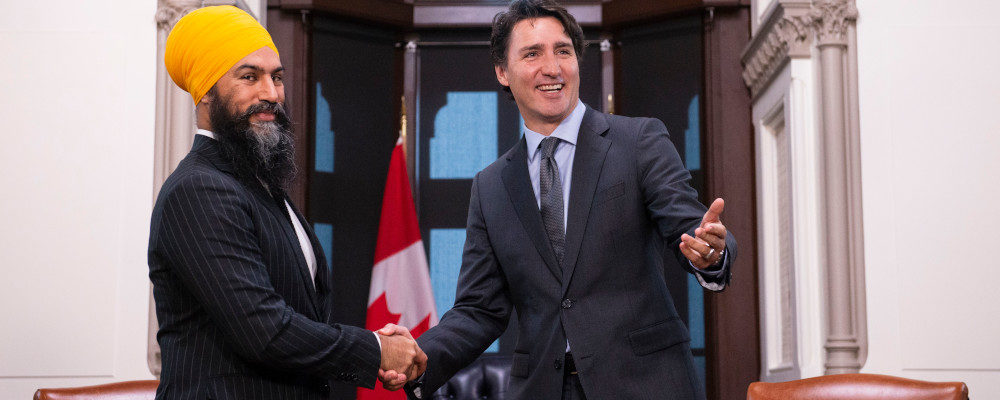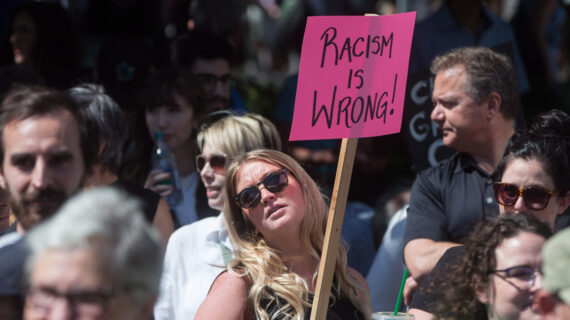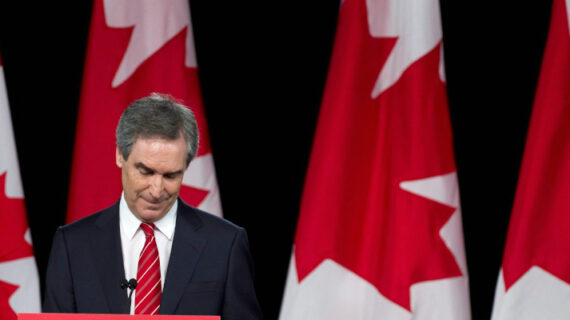The Liberal-NDP governing agreement1“Today, the Prime Minister, Justin Trudeau, announced an agreement reached by the Liberal Party of Canada and the New Democratic Party in Parliament, Delivering for Canadians Now, A Supply and Confidence Agreement.” https://pm.gc.ca/en/news/news-releases/2022/03/22/delivering-canadians-now may not technically be a coalition, but in practice it may be worse.
A coalition government in the Westminster parliamentary system is, as the name implies, a government made up of more than one political party. This is what happened in the United Kingdom in 2010, when David Cameron, whose Conservative Party had won the most seats but fallen short of a majority, reached a power-sharing agreement with the third-place Liberal Democrats. The government consisted of sixteen Conservative cabinet ministers and five Liberal Democrats, with Lib-Dem leader Nick Clegg taking the title of deputy prime minister.
We have had coalition governments in Canada too, but since Confederation only at the provincial level. Federally, our coalitions are notorious as aborted failures. During the First World War, Robert Borden proposed a unity government to support conscription, but he was rebuffed by Liberal leader Wilfrid Laurier. In response, Borden created a new governing party, the Unionist Party, which included some floor-crossing Liberals who were pro-conscription.2“In early 1917, during World War I, recruitment for the Canadian Expeditionary Force fell to a very low level. PM Sir Robert Borden, opposed to any reduction in Canada’s commitment to the war effort, announced on 18 May 1917 that the government would introduce conscription to Canada. On May 25 he proposed to Liberal leader Sir Wilfrid Laurier that the Liberals and Conservatives form a Coalition Government to carry through the measure. After Laurier rejected the proposal on June 6, Borden tried to strengthen his government by bringing in individual Liberals and prominent political independents. His early efforts met with little success. In late summer, however, the Wartime Elections Act and the Military Voters’ Act appeared to increase the political prospects for a government supporting conscription. These Acts, together with strong pro-conscription sentiment in the English press and personal convictions that overrode party boundaries, made several Liberals and independents decide to accept Borden’s suggestion. On Oct 12 Borden announced the formation of a Union government made up of 12 Conservatives, 9 Liberals or independents, and one labour representative. A general election in Dec 1917 gave the Unionists a large majority.” https://www.thecanadianencyclopedia.ca/en/article/union-government
More recently, and doubtless foremost in the mind of voters and politicians, was the attempt by the NDP, Liberals, and the Bloc Quebecois to oust the minority Conservative government during the global financial crisis in 2008. That agreement was a strange hybrid of a coalition and what is happening today. It proposed that, after a vote of no confidence in the Harper government, the Liberals and NDP would form a coalition government. But, because they would still not have as many combined seats as the Conservatives let alone a majority, their coalition would be supported by a supply and confidence agreement with the Bloc.
The rest of the story is well known. Harper staved off the no-confidence vote by proroguing parliament for an extended Christmas break, public opinion quickly turned against the proposed coalition, Liberal leader Stephane Dion was replaced by Michael Ignatieff, and the Conservatives were able to pass a budget in early 2009 with the support of the Liberals.3“Controversy erupted in 2008 when Prime Minister Stephen Harper asked Governor General Michaëlle Jean to prorogue Parliament. This happened shortly before a confidence vote that could have defeated the Conservative Party’s minority government; the Harper government would have been replaced with an NDP– Liberal coalition supported by the Bloc Québécois. After talking with constitutional experts amid intense public and media scrutiny, Jean agreed to Harper’s request. His government survived.” https://www.thecanadianencyclopedia.ca/en/article/prorogation-in-canada They would go on to govern for another two-and-a-half years before winning a majority in 2011. It was a bumpy ride, but the parliamentary system worked in the long run, as it always does.
The parliamentary system will continue to work today too…eventually. But in the meantime, the Liberal and NDP agreement will severely strain its care principle of responsible government.
Although the NDP didn’t even manage to wrangle so much as a single seat at the cabinet table out of the Liberals, Jagmeet Singh agreed to prop up Trudeau’s Liberals until June 2025 and the Liberals agreed not to call an election before then. During the three years in between, the Liberals committed to delivering or making progress on a number of policies, including national dental care and pharmacare, but also on housing, taxes, and labour policy (this may be the first document issued by a Canadian prime minister that uses the word “scabs”).
In return, the NDP “agrees to support the government on confidence and budgetary matters—notably on budgetary policy, budget implementation bills, estimates and supply. Most importantly, “[t]he NDP would not move a vote of non-confidence, nor vote for a non-confidence motion during the term of the arrangement.” It is this provision that undermines the principle of responsible government. By extending its formal support for the government in the House and on committees, the NDP has weakened the accountability that responsible government is supposed to ensure.
The roots of responsible government run back to the Stuart era and parliament’s attempts to impeach the King’s ministers. This established the idea that the King’s closest advisors could be held accountable and removed from office by parliament for their acts on behalf of the Crown, but it was not until almost two centuries later that parliament’s power to defeat a government and force the formation of a new one was clearly established and acquired the status of a fundamental principle of parliamentary government. (So enduring was the patronage system that preceded the introduction of responsible government that, as late as 1832, the Duke of Wellington could wonder “How is the King’s government to be carried on if the [First Reform] bill passes?”)
In Canada, the introduction of responsible government followed the recommendation in the Durham Report of 1839 that the colonies of British North America, which had until then been administered from Britain by an appointed Governor General, be permitted to control their own government through their elected representatives.4“In his report to the British Parliament, Durham said that the troubles in Upper and Lower Canada were the result of a misuse of power by the oligarchies and a clash between the appointed Executive branch and the elected Assembly. He realized the colonies should have a more accountable government.” http://www.canadahistoryproject.ca/1840/1840-10-durham-report.html Responsible government thus began as a Canadian repudiation of direct rule from Britain, but it also had the effect of establishing in Britain the idea of responsible government as government with the consent of the elected representatives of the people.
Canadian scholar of parliamentary government, Philippe Lagassé, has explained what this means in practice: “When Canada is said to have a system of responsible government, we can take this to mean that the Cabinet is responsible to the Commons for the affairs of government, and that the House is the central actor in government formation.” It is the House of Common’s central role in forming (and unforming) government, along with the government’s power to dissolve parliament, that give the idea of responsible government teeth. Together these powers force cabinet and parliament to work together under the ever-present and chastening threat of the ultimate sanction of dissolution by one side or the other.
The NDP’s agreement to support the government removes this threat and its chastening effects for three years. At least in principle, the Liberal government can now stop worrying about being held to account by the House of Commons until the next election in 2025. By agreeing not to support a non-confidence motion—no matter what the Liberals get up to in the meantime, as long as they also abide by the terms of the agreement—Singh has committed the NDP to not holding the government to account. In other words, the agreement effectively suspends the operation of responsible government for three years.
Yes, something like this happens in the case of majority governments, whose freedom to act is constrained only by the desire of its MPs to be re-elected. But in that case, the people have voted for a majority government. In 2021, fewer than a third of Canadians voted for Trudeau’s Liberals (only 20 percent, if you count Canadians who didn’t bother to vote) and fewer than one in five voted for Singh’s NDP (barely 10 percent, factoring in turnout). There isn’t even the fig leaf of a democratic mandate for the NDP to support a Liberal government in a de facto majority position.
This matters because parliamentary accountability means more than scrutinizing legislation. Most of what a government does, it does under its prerogative powers or under powers delegated to it by existing legislation. Virtually every decision the government makes—from allocating billions of dollars of grant money to deciding the annual immigration levels, from negotiating trade deals to deploying the Canadian Armed Forces—happens outside parliament. We rely on the House of Commons to hold the government accountable for every single decision it makes in and out of parliament.
This includes some of the most controversial and unlawful decisions in recent Canadian politics. The Sponsorship Scandal did not happen in parliament.5“The sponsorship scandal, AdScam or Sponsorgate, was a scandal in Canada that came as a result of a federal government “sponsorship program” in the province of Quebec involving the Liberal Party of Canada, which was in power from 1993 to 2006.” https://www.wikiwand.com/en/Sponsorship_scandal Nor did any of Trudeau’s ethics and conflict of interest violations, the government’s obstruction of parliament’s request for documents related to the firing of two scientists from the Winnipeg virus lab, or the declaration of a state of public order emergency. If the government were to declare war on Russia, that would not happen in parliament either. Would Singh, whose party opposes even lethal military aid to Ukraine, really support going to war? There is no “anti-war” loophole in the agreement. On all these matters, either the NDP is now toothless, or the new agreement is.
This brings us to the reality behind the rhetoric. I have said that “in principle, the Liberal government can now stop worrying about being held to account” and that “the agreement effectively suspends the operation of responsible government for three years.” Those caveats are important. The one thing this agreement cannot do is suspend the normal operation of politics. It does not change the fact that every Liberal and NDP MP will still have to consider the public’s reaction to the government every day between now and the next election.
The safety valve in our parliamentary system is the connection between individual members and their constituents. Whatever a government does, the MPs who support it are responsible for it every time they go back home to knock on doors and ask their neighbours to vote for them again. This means that, whatever the agreement says, it will only last as long as it proves popular. A Sponsorship-level scandal, a (G*d-forbid) war, or a decisive public turn against the government over inflation, cost-of-living, or its arrogance and incompetence would mean the agreement is not worth the pixels it’s printed on.
Either the agreement means something and changes things, or it doesn’t. If it does, then it means less effective scrutiny and accountability for the government; if it doesn’t, then what’s all the fuss about and what was the point? Time will tell which it is. And, ultimately, the success or failure of this coalition-lite pact will be decided in June 2025—if it lasts that long.




